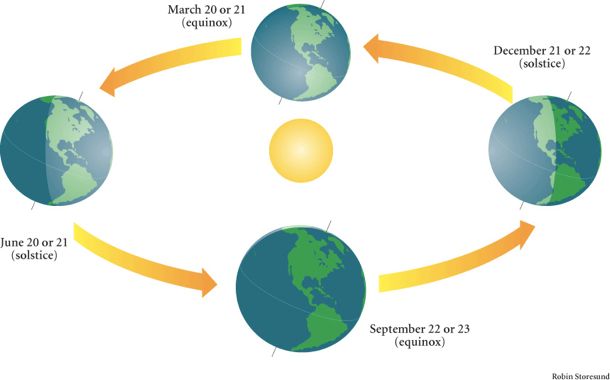
Photo above: Sunrise over Red Sea by Graham Telford.
Around this time of year – at sunset – there’s a natural phenomenon you might never have imagined. That is, the sun actually sets faster around the time of an equinox. The fastest sunsets (and sunrises) occur at or near the equinoxes. And the slowest sunsets (and sunrises) occur at or near the solstices. This is true whether you live in the Northern or Southern Hemisphere.
And, by the way, when we say sunset here, we’re talking about the actual number of minutes it takes for the body of the sun to sink below the western horizon.

Equinoxes and solstices, via Geosync
Why does the sun set so quickly around the equinoxes? At every equinox, the sun pretty much rises due east and sets due west. That means – on the day of an equinox – the setting sun hits the horizon at its steepest possible angle.
Meanwhile, at a solstice, the sun is setting farthest north or farthest south of due west. The farther the sun sets from due west along the horizon, the shallower the angle of the setting sun. That means a longer duration for sunset at the solstices.
The sunset duration varies by latitude. Farther north or south on the Earth’s globe, the duration of sunset lasts longer. Closer to the equator, the duration is shorter. But let’s just consider one latitude, 40 degrees north, the latitude of Denver or Philadelphia in the United States, and Beijing in China. At that latitude, on the day of equinox, the sun sets in about 2 3/4 minutes.
On the other hand, the solstice sun sets in roughly 3 1/4 minutes at 40 degrees latitude.
When is the equinox? The September equinox will arrive on September 22, 2020, at 13:31 UTC. Although the equinox happens at the same moment worldwide, your clock times will depend on your time zone. For time zones in the continental U.S., this equinox comes on September 22 at 9:31 a.m. EDT, 8:31 a.m. CDT, 7:31 a.m. MDT or 6:31 a.m. PDT. Translate to your time zone.
Bottom line: The fastest sunsets of the year are happening now, around the time of the September equinox.
All you need to know about the upcoming equinox
Are day and night equal on the equinox?
from EarthSky https://ift.tt/2IjgwIi

Photo above: Sunrise over Red Sea by Graham Telford.
Around this time of year – at sunset – there’s a natural phenomenon you might never have imagined. That is, the sun actually sets faster around the time of an equinox. The fastest sunsets (and sunrises) occur at or near the equinoxes. And the slowest sunsets (and sunrises) occur at or near the solstices. This is true whether you live in the Northern or Southern Hemisphere.
And, by the way, when we say sunset here, we’re talking about the actual number of minutes it takes for the body of the sun to sink below the western horizon.

Equinoxes and solstices, via Geosync
Why does the sun set so quickly around the equinoxes? At every equinox, the sun pretty much rises due east and sets due west. That means – on the day of an equinox – the setting sun hits the horizon at its steepest possible angle.
Meanwhile, at a solstice, the sun is setting farthest north or farthest south of due west. The farther the sun sets from due west along the horizon, the shallower the angle of the setting sun. That means a longer duration for sunset at the solstices.
The sunset duration varies by latitude. Farther north or south on the Earth’s globe, the duration of sunset lasts longer. Closer to the equator, the duration is shorter. But let’s just consider one latitude, 40 degrees north, the latitude of Denver or Philadelphia in the United States, and Beijing in China. At that latitude, on the day of equinox, the sun sets in about 2 3/4 minutes.
On the other hand, the solstice sun sets in roughly 3 1/4 minutes at 40 degrees latitude.
When is the equinox? The September equinox will arrive on September 22, 2020, at 13:31 UTC. Although the equinox happens at the same moment worldwide, your clock times will depend on your time zone. For time zones in the continental U.S., this equinox comes on September 22 at 9:31 a.m. EDT, 8:31 a.m. CDT, 7:31 a.m. MDT or 6:31 a.m. PDT. Translate to your time zone.
Bottom line: The fastest sunsets of the year are happening now, around the time of the September equinox.
All you need to know about the upcoming equinox
Are day and night equal on the equinox?
from EarthSky https://ift.tt/2IjgwIi


Aucun commentaire:
Enregistrer un commentaire